Currency:
USD
ISK
USD
EUR
CAD
SEK
DKK
NOK
GBP
Short on time but big on Icelandic travel? Iceland's Ring Road is a legendary sightseeing route promising endless discoveries no matter how long you circle it. Get ready to explore – we'll share all the tips, highlights, and insights to make your Iceland road trip unforgettable!
If you're coming to Iceland for a short time, one week on the Ring Road transforms your visit into an epic adventure, hitting all the island's must-sees.
Also known as Route 1, it’s the most popular route and Iceland’s main highway. It winds around the entire island, showcasing everything from glacier lagoons and cascading waterfalls to volcanic craters and otherworldly landscapes.
The best part? It's an adventure you can experience over a few days or enjoy for over a week. Make the most of your days in Iceland with our detailed Ring Road itinerary!

Iceland’s Ring Road is 1,332 kilometers (828 miles) long. While the main route bypasses Snaefellsnes Peninsula and Westfjords, plenty of detours along the road lead to geothermal areas, heart-pumping waterfalls, picturesque fjords, and everything in between. Going around the entire Ring Road is a lifetime adventure, and it’s totally worth the ride.
There’s never a one-size-fits-all answer for whether you should self-drive on Iceland’s Ring Road or join a guided tour.

Driving yourself lets you explore at your own pace, stop when you feel like it and however many times you want, and take detours to hidden gems, deciding which those are for you!
You won’t be disappointed if you choose to steer your adventure, but there’s homework to be done to maximize your self-driving experience. Ideally, you’d prepare for your Ring Road trip by researching routes, attractions, and accommodations, choosing the best. And still, you could miss out on historical and geological details without the help of a guide.
If this sounds like too much work, our guided Ring Road tour might be your pick! It’s a hassle-free way to comfortably explore Iceland’s highlights, gaining insights and learning folklore legends from our knowledgeable guides. You’re up for an enriching journey with the best value, which includes accommodation and some of the most authentic Icelandic places you can easily miss on your own.
Short answer: Absolutely! Driving in Iceland comes with its perks. You’re not tied to a schedule; you follow your own plan, and it’s adventurous. It’s as easy as renting a car of your preference, packing those bags, and having our Iceland Ring Road itinerary ready!
Depending on your demands, it can also be a very budget-friendly way to sightsee Iceland. If you’re a free spirit after a more intimate trip and can’t get enough of those scenic picnic stops, self-driving the Ring Road is definitely for you. This way, you can see the best locations and explore different regions, returning with an enhanced sense of wonder and freedom.
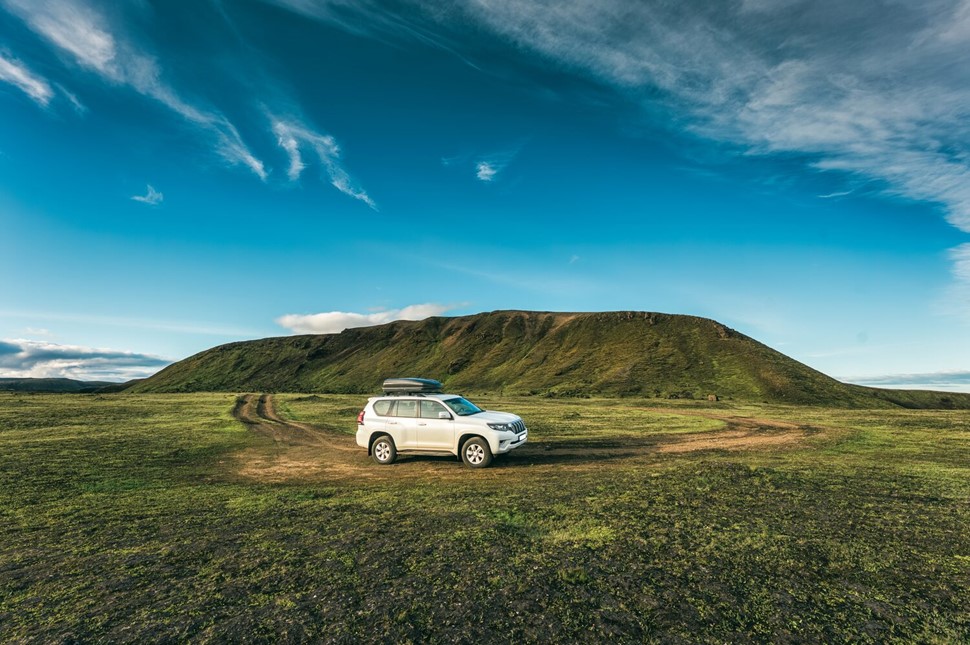
The highway takes you on a scenic loop around the whole island, which would require roughly 17 hours of non-stop driving to complete. Realistically, we would recommend a minimum of 5 days of exploration for a comprehensive experience.
Everyone’s circumstances are different, but it’s best to spend 6 to 10 days on the Ring Road, checking in with countless Icelandic destinations at a pace that will allow you to unwind and take everything in without rushing.
Driving in Iceland is a whole different experience between summer and winter.
Summer offers sunshine, longer daylight hours, and generally clear roads, making navigation and exploring a breeze. You can even access the scenic but rugged F-roads of Iceland’s Central Highlands, which are closed during winter.
Winter brings its own magic with a wonderland of snow and potentially the Northern Lights. The trade-off is shorter daylight hours, icy roads, and possible road closures, requiring a 4x4 vehicle and much more caution behind the wheel.

We view six days on the Icelandic Ring Road to be just enough to fit most of the iconic Icelandic landmarks into your journey. It’s going to be a dynamic ride, ticking off one bucket list destination after another, with each day planned out to the max!
If that’s you, read on to find out what daily adventures we’ve prepared for you with our 6-day Iceland Ring Road itinerary. So fuel your gas tank, buckle up, and let’s go!
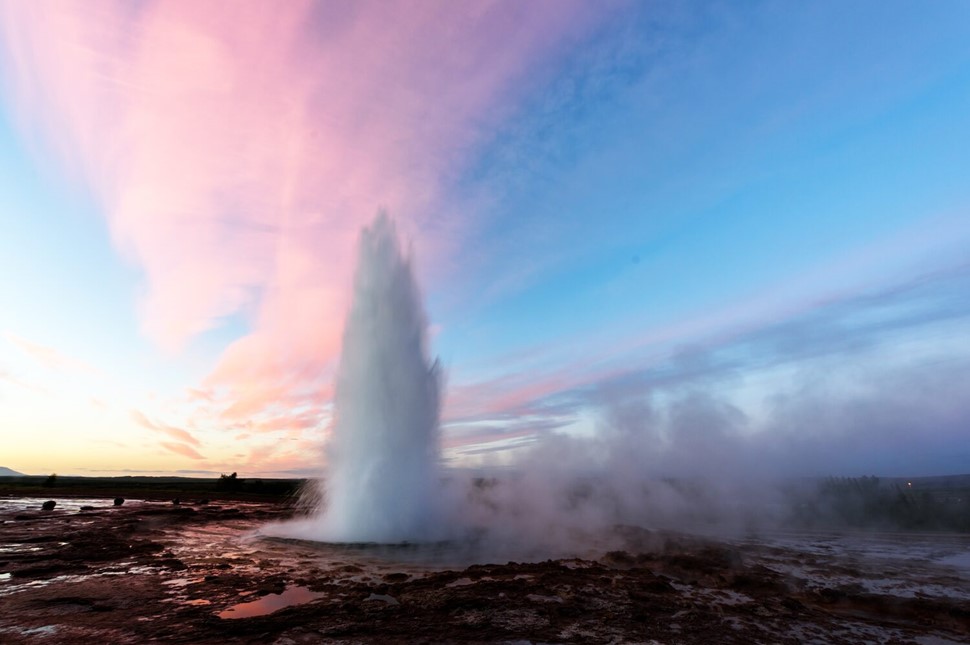
A stone's throw from Reykjavik and just off the Ring Road lies the Golden Circle, showcasing Iceland's geological wonders and historical significance. This sightseeing loop journey is popular with tourists for its full-on Icelandic experience. The Golden Circle is a great way to start off your adventure as it unveils three must-see destinations of Iceland:
Bonus tip: Combine your Golden Circle experience with snorkeling in Silfra fissure. You should have time for both!
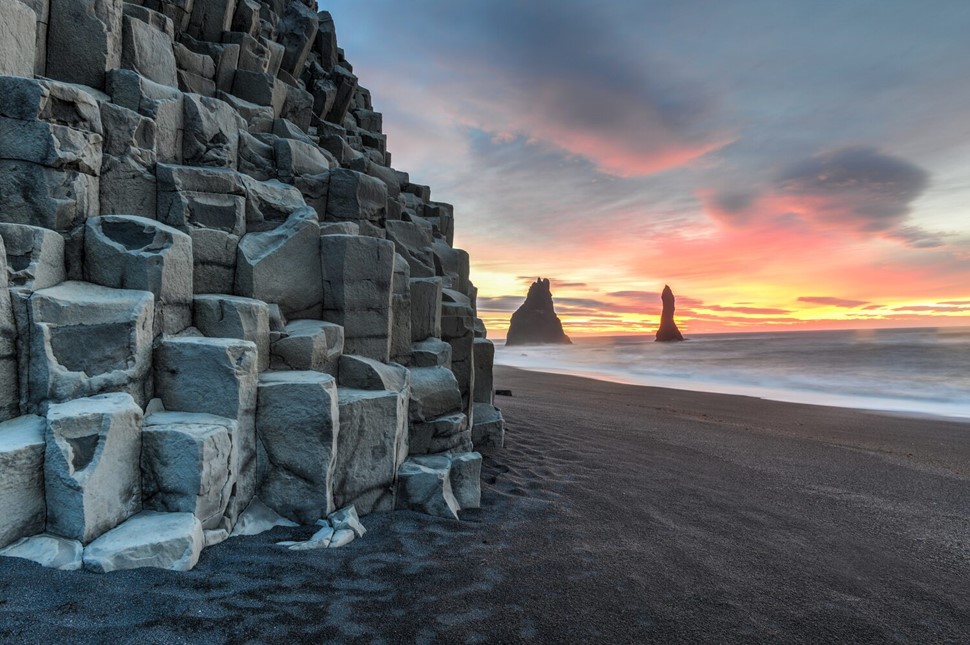
A classic way to go about your Ring Road adventure is going south! Iceland’s South Coast is a land of contrasts, packed with incredible landscapes and powerful sights. The region is easily accessible from Reykjavik and the Golden Circle, which allows the smooth continuation of our second day on the Icelandic Ring Road.
Venturing south, you’re up for a cascade of wonders, starting with two of Iceland's most iconic waterfalls: Seljalandsfoss and Skógafoss.
One of the glaciers is Solheimajokull, known for its accessibility. Have a refreshing walk on it with an easy and spectacular guided glacier hike. What’s convenient is that you can join the tour right there and then! The meeting point is at a glacier base, only 6 km (0.6 mi) from Skógar village, just off the Ring Road.
Solheimajokull is an outlet glacier of a larger Mýrdalsjökul Glacier, the fourth largest glacier in Iceland and home to the world-famous Katla Volcano. Beneath the volcano lies the astonishing Katla Ice Cave, which you can experience with a guided tour. The meeting point for the tour is as close as the nearby town of Vik, just down the road.

Right before Vik stretches the dramatic Reynisfjara Beach, the world’s famous black sand beach. This jet-black sand beach, pounded by powerful waves, is truly unique. The Reynisdrangar sea stacks with towering basalt columns jutting from the ocean add to the otherworldly atmosphere of the beach. When you reach it, you will see why it's been a popular filming location, featuring in films like Star Wars and Game of Thrones!
No South Iceland adventure is complete without seeing the magic of Jökulsárlón Glacier Lagoon. The lagoon’s ethereal world is formed by the meltwater from Vatnajökull, Europe's largest glacier. Its beauty captivated filmmakers, appearing in James Bond and Tomb Raider.
For an unforgettable experience, combine glacier hiking with kayaking on Jökulsárlón. Don’t forget to take a stroll along the nearby Diamond Beach, a constantly evolving coastal stretch where icebergs shine like diamonds against the black sand.
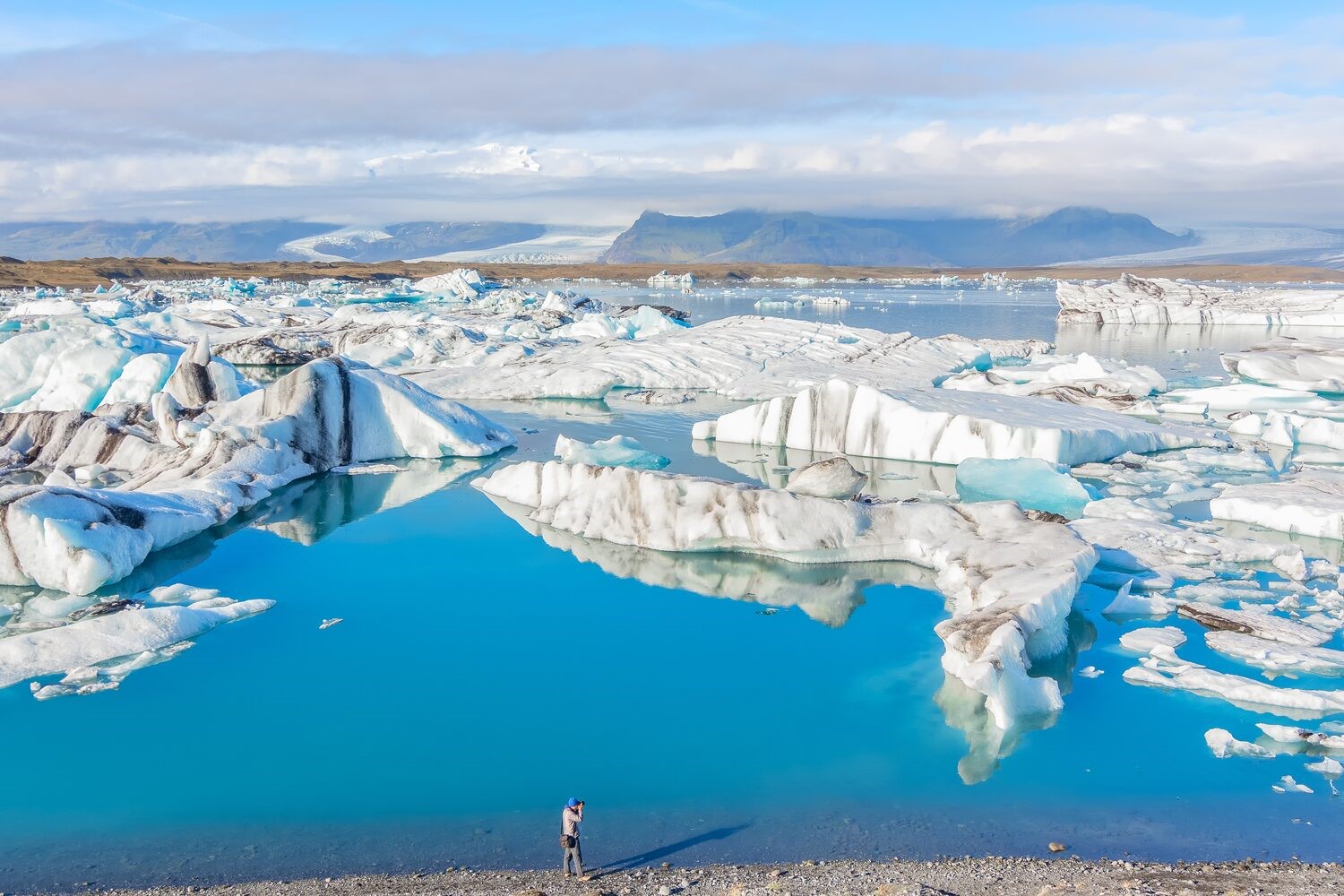
After a day of exploration, unwind at a charming local hotel. Depending on where your journey ends for the day, consider the welcoming Hotel Geirland or the cozy Hotel Hof. Both offer comfortable accommodations, delicious meals featuring local ingredients, and convenient locations serving as perfect bases for further exploration. Rest that weary head and wake up to an exciting tomorrow filled with more adventures to conquer!
Bonus tip: If time allows, explore Fjaðrárgljúfur Canyon, the hidden gem of South Iceland that’s been featured in a Justin Bieber clip, making it world-famous.
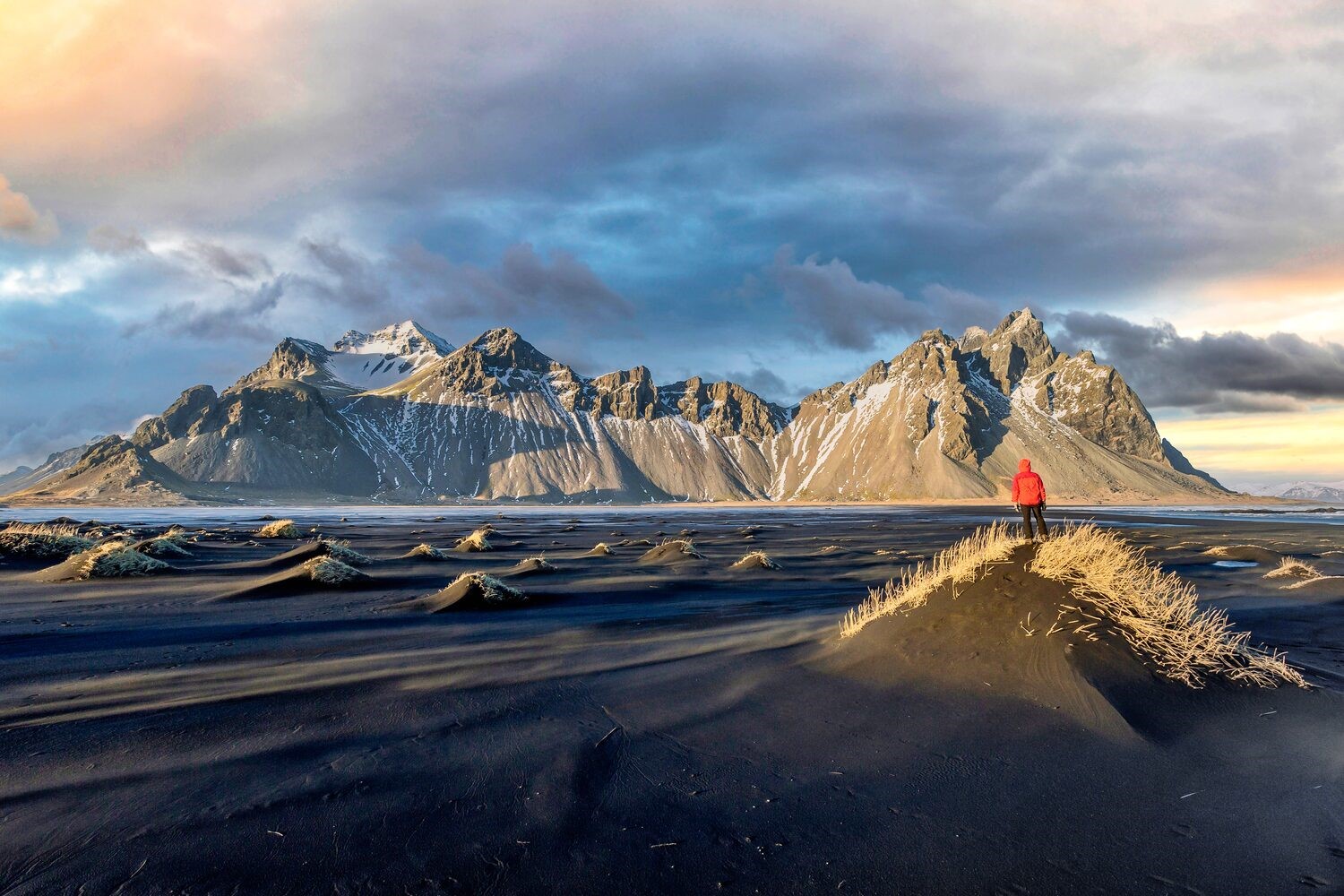
Venture further along Iceland's coastline to discover the authentic side of Iceland beyond the beaten path. This region is a hidden gem tucked away in the island's easternmost part. Imagine towering mountains carved by deep fjords with charming, colorful fishing villages on their shores. Untouched by volumes of tourists, Iceland’s Eastfjords offer a glimpse into Iceland's traditional way of life, a place where time seems to slow down.
Visiting Höfn will mark your transition from South to East Iceland. In contrast to the isolated surrounding areas, this town will seem like a bustling hub. And it’s true! With a modest 2,200 residents, it’s a local center for tourists and a place rich with history, museums, and cuisine. Its atmosphere is absolutely stunning, too. It’s a colorful harbor town embraced by breathtaking mountains - a picture-perfect setting exemplifying Eastfjords villages.
Just a short driver further from Hofn is Stokksnes, an isolated chip of land stretching south from the Ring Road. You won’t miss it; you’ll know you’re close as soon as you reach the Almannaskard Pass. There’s a viewpoint where you can enjoy the serene views of the Hornafjörður region. Deepening into Stokksnes, you can see the mysterious Vestuhorn Mountain and walk by the “Viking Village,” an open museum-like prop site for filmmaking.
The rest of Stokksnes is as remote and isolated as it gets to the point that its atmosphere is almost mythical. No wonder the area attracts many photographers who capture its dramatic mountainscapes and black sands.
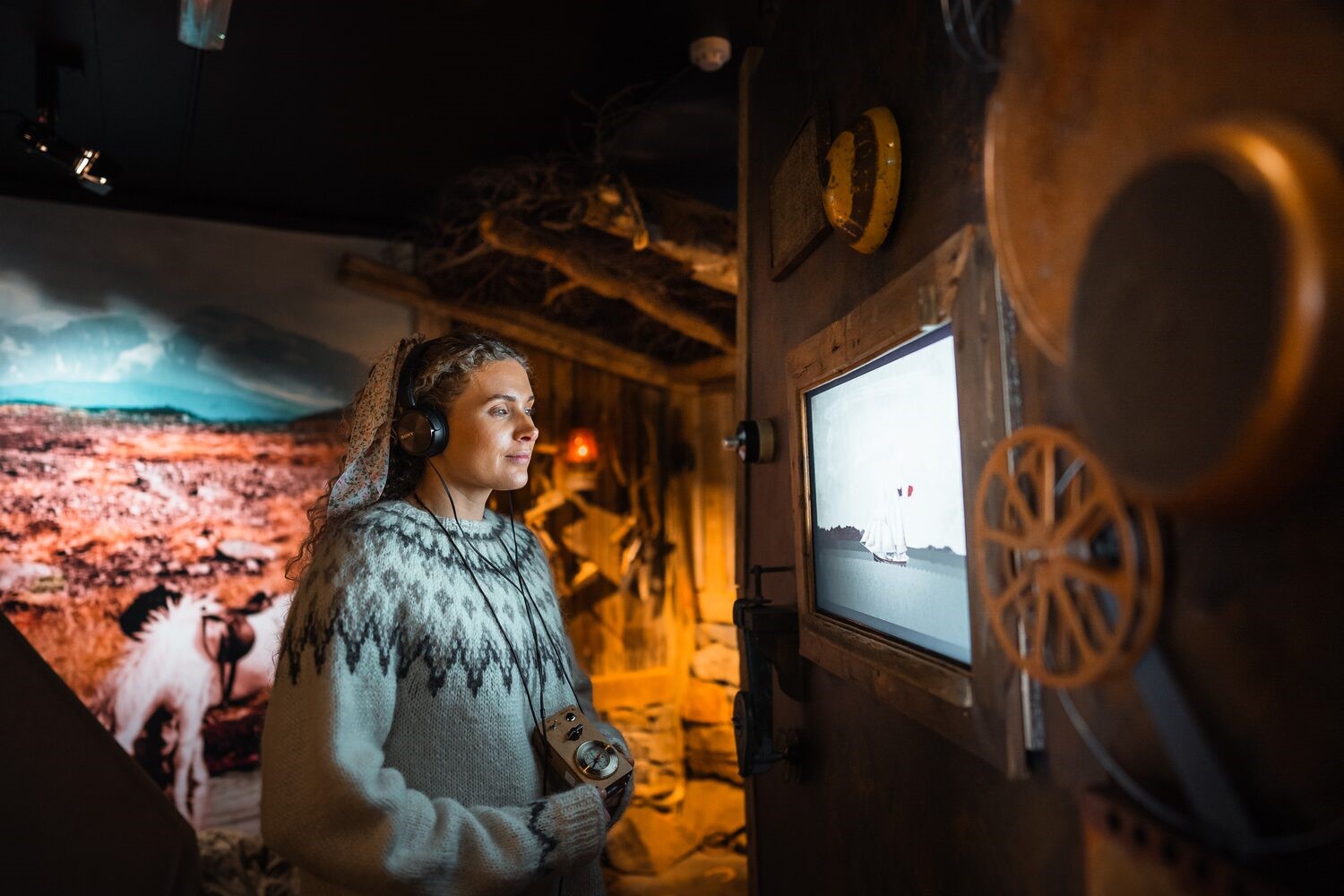
The Eastfjords are a paradise for nature enthusiasts. The unspoiled nature of the region attracts hikers who can explore trails, waterfalls, and lava caves, as well as the magical Hallormsstaður, Iceland's largest forest. It’s also the home of the graceful wild reindeer, found only in this region. Drop by the local Wilderness Center for a social exchange and a hearty meal! It’s a local hub providing information on local wildlife as well as comfortable accommodation.
After a peaceful day around the Eastfjords, why not stop by the geothermal Vök Baths in Egilstaðir, the largest town in East Iceland? Imagine a perfect pause to break up your day on the road: soaking in warm therapeutic waters while looking over the picturesque Urriðavatn lake nearby.
As the sun is soon to dip below the horizon, you can take a short drive east from Egilstaðir and discover the pretty town of Seyðisfjörður. Cozily situated at the head of the narrow Seyðisfjörður fjord, the village displays the authentic everyday life of traditional Icelanders. Wander through this charming town before settling into a cozy local hotel for a well-deserved rest, recharging your batteries for the day ahead.
Bonus tip: Check out the breathtaking Hengifoss Waterfall, the third-longest waterfall in Iceland with an impressive 128-meter (420-foot) drop.
Excited about the fourth day of your Icelandic road trip? Iceland’s North East will unveil the rugged, volcanic landscapes of the island. Witness the incredible forces of nature that have sculpted this dramatic region.

Rise early to conquer the breathtaking Stuðlagil Canyon before the crowds arrive. This unique basalt rock canyon is very special. Its turquoise waterway flows through a dramatic corridor framed by natural columns. The reward for an early start? Racing to the canyon to beat the crowds pays off as you get to enjoy the undisturbed atmosphere of the canyon’s incredible landscape.
After checking in with the canyon’s serene setting, continue your adventure up north to the volcanic Lake Mývatn. Here, dramatic landscapes meet geothermal activity, reflecting the region's volcanic legacy. Stop for a minute and take in the breathtaking scenery of the lake and its surroundings. If time is on your side, unwind in the nearby Mývatn Nature Baths - the perfect addition to a remarkable day.
Dimmuborgir Lava Field is, you guessed it, a lava field, and it’s just next to Lake Myvatn! But it’s not just some lava field - Dimmuborgir is like stepping into another world. Towering pillars of black lava, some reaching surprising heights, take on abstract forms. Here, moss grows on solidified lava, adding a touch of refreshing green to the otherwise stark landscape. The maze of caves and natural arches hint at the fiery forces that gave birth to the field’s dramatic scenery.
Explore the nearby Hverfjall Crater next! It’s a near-perfect circle carved into the Icelandic landscape, a stunning sight to behold. It boasts an enormous tephra cone formed by a volcanic explosion roughly 2,500 years ago. Though a landslide disrupted its perfect symmetry, the crater's dark slopes lead up to a dramatic rim offering 360° views of the surrounding volcanic landscape.
Head north, and you’ll reach the Krafla Volcano with the namesake lava fields that surround it. The volcano is a giant in North Iceland’s Krafla volcanic system. Its caldera, a massive depression left by past eruptions, hosts a blue lake in its depth. The volcano is surrounded by the otherworldly Krafla Lava Fields. Black lava flows, some still radiating heat, stretch across the landscape, showing the occasional steaming vents and bubbling mud pools.
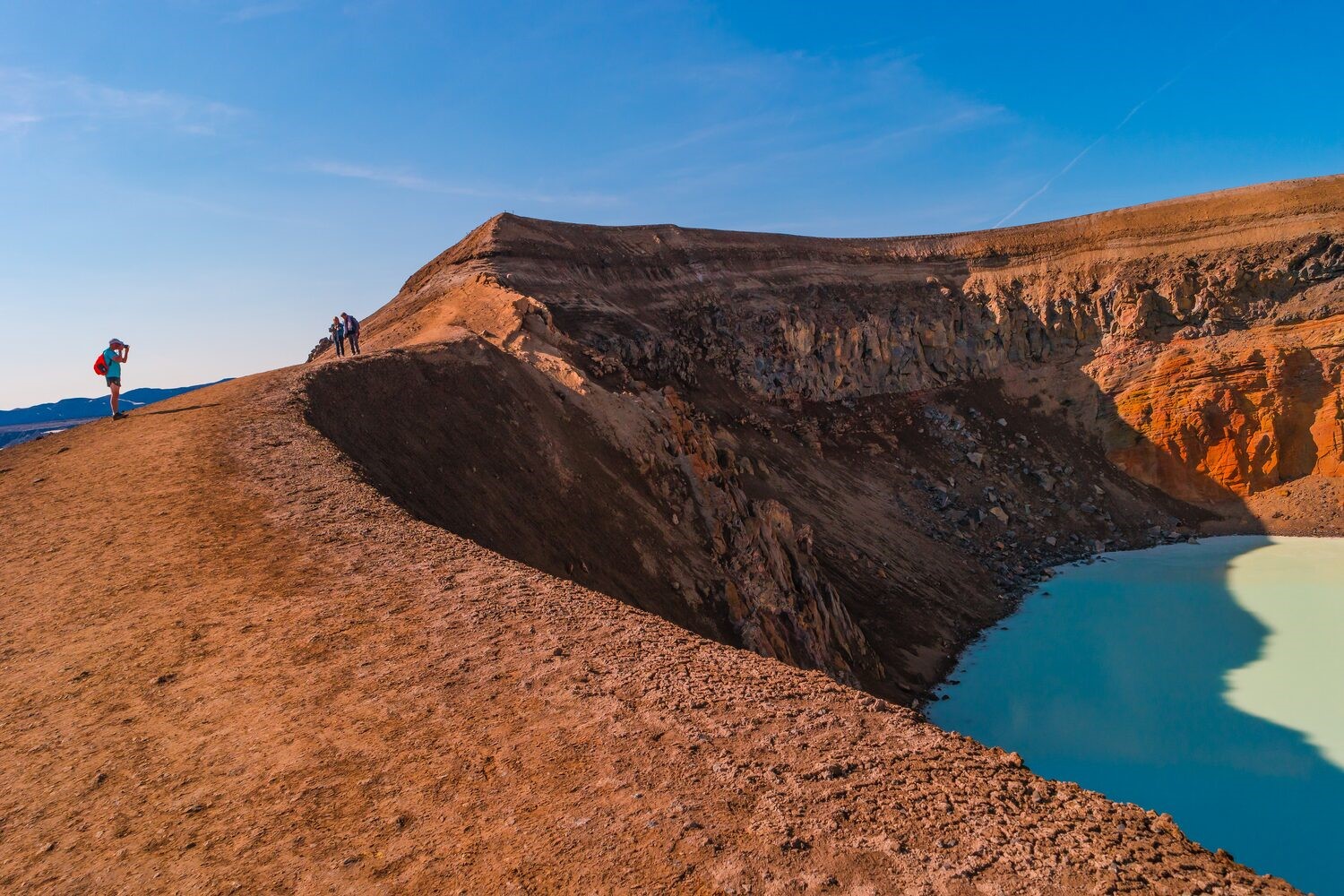
Askja Caldera is an intriguing destination closer to Iceland’s Central Highlands. Its lunar landscapes will make you wonder if you’re still on Earth. The caldera is a vast volcanic depression cradling a milky-blue lake called Öskjuvatn, one of the deepest in the country. Within this dramatic landscape sits Viti, a smaller crater formed by a later eruption. Viti translates as "hell" in Icelandic, a fitting name for its vibrant turquoise geothermal lake that simmers with volcanic activity.
Driving there yourself is an adventure for experienced off-roaders. Bear in mind that you'll need a powerful 4x4 vehicle to handle the rough, unpaved tracks (F-roads) leading through the remote terrain. Instead, opt for a guided tour conveniently departing from Myvatn, your area of exploration for the day!
Bonus tip: Join a Diamond Circle tour from Akureyri for the day as an alternative to driving yourself. This guided tour covers all the above landmarks and beyond!
Leaving behind volcanic landscapes, stark lava fields, and geothermal activity, head to the northernmost part of the island. Here, more untamed beauty awaits in the form of fjords and charming fishing villages.
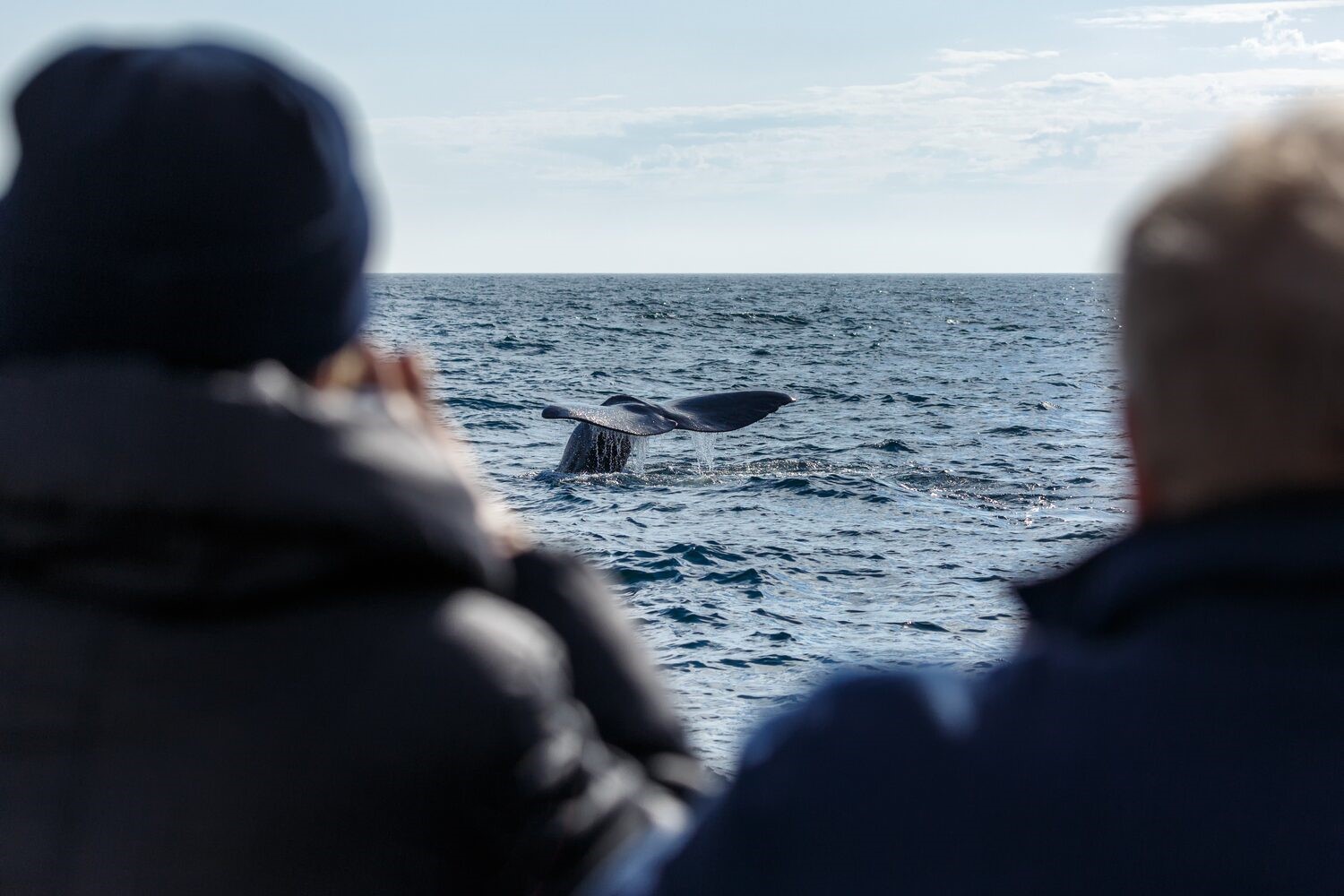
Nestled in the far north of Iceland lies Akureyri, the vibrant "Capital of North Iceland." Although its population is a cozy 18,000, Akureyri boasts a rich cultural scene with museums, art centers, and even the world's northernmost botanical garden! This charming town also serves as a major port and local fishing hub, so be sure to check it out.
Akureyri rests at the head of Eyjafjörður, the longest fjord in northern Iceland. This majestic waterway stretches for 60 kilometers (37 miles), framed by snow-capped peaks. Eyjafjörður serves as a local hub for agriculture, fishing, and tourism, inviting travelers to explore its rich natural beauty, diverse wildlife, and breathtaking scenery. Go on a scenic coastal drive, stopping at your leisure to appreciate the surroundings or enjoy a picturesque picnic.
Driving north along Eyjafjörður’s western coast will lead you to the charming village of Dalvik. About an hour's drive from Akureyri, this colorful village offers captivating views of Hrísey Island sitting in the middle of the fjord.
Dalvik's calm waters and abundant food sources make it a prime location for whale watching. Several species lurk in these North Icelandic waters, including humpback whales, minke whales, and even the awe-inspiring blue whale, the largest creature on Earth. Trade your car for a boat and witness these majestic animals in their natural habitat – a truly wonderful experience!
Back on land, you can choose to call it a day or venture further into Tröllaskagi, or "The Troll's Peninsula." This region boasts another charming fishing village, Siglufjörður, holding a significant role in the local herring fishing industry. If you’re seeking a tranquil escape, extend your day with a scenic drive along Iceland's North Coast through more eye-catching villages and agricultural areas. Keep an eye out for a comfortable overnight stay to resume your road trip the next day!
Bonus tip: If you feel like squeezing in some action-packed thrills, go for an extreme rafting tour. Alternatively, join a family-friendly rafting experience.
West Iceland, beyond the well-known Snaefellsnes Peninsula, boasts diverse landmarks that package your day with Icelandic experience. What can be better than having an all-round experience on your trip’s final day?
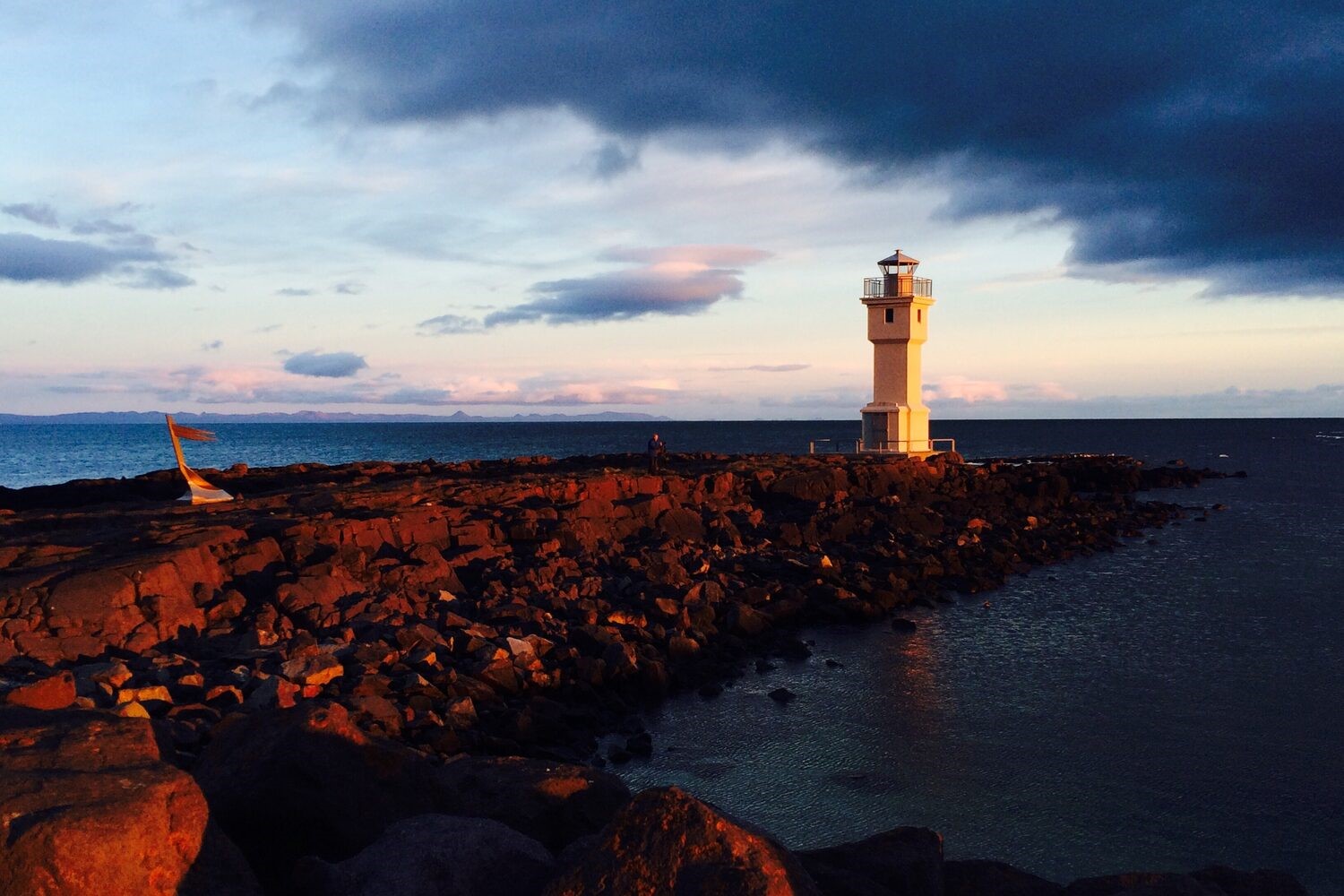
Start your West Iceland experience by navigating towards Deildartunguhver, Europe's most powerful hot spring. Witness its raw geothermal energy in action and discover how it's harnessed for sustainable agriculture. How about an earlier relaxing soak for a change? Take a break at the Krauma geothermal baths, a muscle-soothing haven to recharge for the adventures ahead.
Dramatic coastlines with charming fishing villages like Akranes and Borgarnes offer a glimpse into Iceland's rich maritime heritage. Nestled close together along Iceland's west coast, Akranes and Borgarnes offer contrasting experiences. Akranes, nicknamed "Iceland in Miniature," boasts a colorful harbor, historical sites, and a relaxed atmosphere. Borgarnes, the region's largest town, features cultural attractions and serves as a gateway to the dramatic landscapes of the Snaefellsnes Peninsula.
Towering over West Iceland at a mighty 848 meters (2782 feet) stands Hvalfell, or "whale mountain," and it’s a dormant volcano that commands respect. It’s situated just beside Hvalvatn, an impressive lake that’s 180 m (590 ft) deep. Local folklore whispers of a monstrous whale trapped within the lake, a tale that adds to the mountain's mystique. Hikers venturing near Hvalfell can explore the surrounding trails and be rewarded with breathtaking views of the Icelandic landscape.
Round up your unforgettable journey with a stop by Glymur, Iceland's second-highest waterfall, which is, conveniently, just a miniature drive west of Hvalfell. Feel its powerful currents thundering down a 198-meter (650-foot) drop. Located in West Iceland's Hvalfjordur, the “Whale Fjord”, it's a popular destination for hikers drawn to the challenge of its path. For those visiting, the reward becomes clear: the waterfall's power and the surrounding lush Botnsdalur valley.
Bonus tip: Feeling tired after several days of driving? Understandable! Consider finishing your 6-day journey easy: go for the same sights and more with a Super Jeep tour.
While a 6-day Ring Road adventure fits in many highlights, stretching it to 8 or 10 days transforms your trip. You'll have more time enjoying landmarks you’ve fallen in love with, stretching your geothermal water soaks, or relishing your scenic picnic without rushing to the next stop.
If you can’t get enough of Iceland, below are our suggestions for deeper detours from the Ring Road into Iceland’s most remote parts, hiding gems that are waiting to be discovered!

To go around the entire Iceland is a challenge, including the deep venture into the country’s Westfjords. But if you’re blessed with an extra day or two, consider fitting Westfjords into your itinerary, perhaps at some point after your North Icelandic explorations!
Westfjords is a land untouched by time, where remoteness becomes its own magic. This vast peninsula reaches out into the North Atlantic. Sparsely populated, it has a sense of untouched wilderness. As its name suggests, the Wesftjords region is carved by dramatic fjords. Isafjordur, the largest town in the Westfjords, will be your welcoming hub. Here, you can stock up on fuel and supplies and enjoy a taste of local life before venturing deeper into the wild.
Start with the legendary Latrabjarg Cliffs. These remote cliffs, stretching for miles along the coast, are Europe's westernmost point. Here, the air is alive with the calls of countless birds, including the adorable puffins.

Chase the thunderous roar of Dynjandi Waterfall. This cascading giant, a series of waterfalls tumbling down 100 meters (330 feet), is a force of nature that will blow you away. Take a turn to Hornstrandir Nature Reserve for a more isolated experience. This hiker's paradise is home to the elusive Arctic fox, so keep your eyes peeled as you explore around.
Finally, end your journey on a colorful note at Rauðasandur Beach. Picture this: a vast expanse of red sand, washed by the waves of the Arctic Ocean. Here, the only company you're likely to have are the seals basking on the shore and the countless birds calling this remote paradise home.
Let’s say you’re lucky and have even more time to spend in Iceland. Use it to explore the Snæfellsnes Peninsula! If you want to stick to driving yourself, you can go off the western part of the Ring Road and detour deep into the peninsula, discovering its wonders one after another!
One of the gateways to Snæfellsnes is the town of Borgarnes, a charming Icelandic town with Viking history. Depending on where you are on your journey, going from Route 60 might be a more practical way to fit in your Snæfellsnes Peninsula detour.
Begin your adventure through the peninsula by heading to Gerðuberg Cliffs, which rise like giants. These unique hexagonal columns will leave you awe-struck. Continue along the peninsula’s dramatic coast until you reach the tranquil Ytri Tunga beach. Park your car, enjoy the gentle sound of waves, and watch the beach’s adorable seals.
When you almost reach the western tip of Snæfellsnes, be on the lookout for the Rauðfeldsgjá Gorge. Get out and stretch your legs with a hike through this narrow, deep ravine. Appreciate this historic place linked to one of the Icelandic sagas.
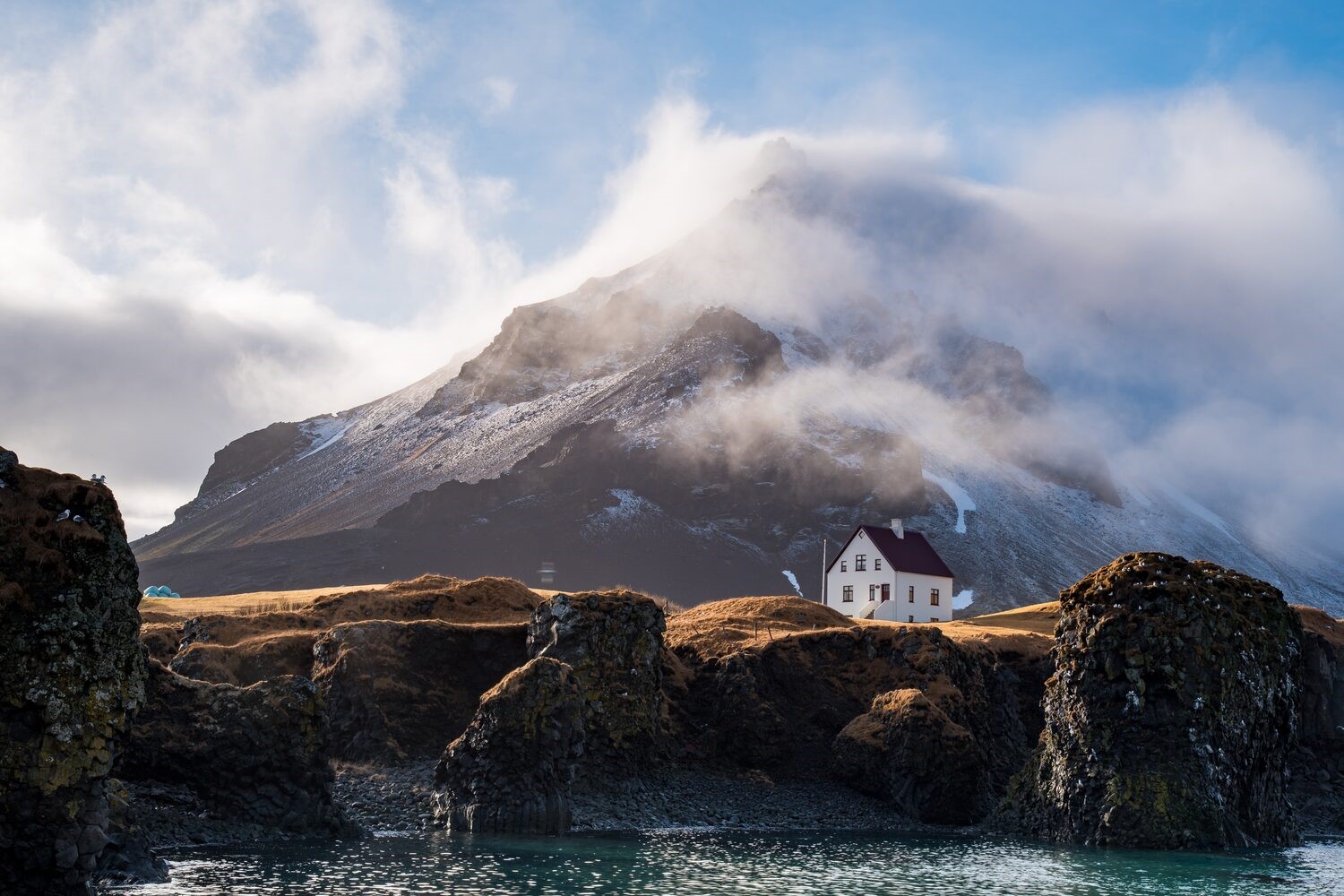
Next, you will find more magic in the Snæfellsjökull National Park. Here, you'll be surrounded by a tapestry of landscapes - rugged coastlines contrasting with spacious valleys. The park is a feast for the senses, offering something for everyone, from geothermal wonders to hidden waterfalls.
Concluding your exploration, check in at Kirkjufell Mountain, a landmark that has captured the hearts of many. This pointed peak, often referred to as "Church Mountain," is a true Icelandic icon. Take in its beauty from every angle, explore the cascading waterfall that tumbles nearby, and soak in the serenity of this unique place.
Now that you’ve had a glimpse into what traveling around Iceland’s Ring Road looks like, it’s time to plan your dream trip with the help of our itinerary! So pack your sense of adventure, lace up your hiking boots, and get ready for the ultimate Icelandic adventure that you will never forget.
Iceland's Ring Road, also Route 1, is a scenic 1,322 km circular highway that loops around the entire country.
Yes, renting a car and driving yourself is the most common way to experience the Ring Road outside of a guided tour.
Allow 6 to 10 days and beyond to enjoy the Ring Road with stops for attractions and exploring.
Yes, 8 days is a good amount of time to comfortably drive the Ring Road and see most of the highlights.
7 days is very doable, but expect a faster pace with slightly less time for detours and activities.
It's possible, but it would be a rushed experience with limited time to explore off the main road.
Renting a car and driving yourself gives you the most flexibility, while going on a guided tour effectively packages the most highlights and insights into the experience.
The Golden Circle is a popular day trip area in South Iceland. The Ring Road encircles the whole country with its countless landmarks but requires several days to complete.
Yes, the Ring Road is a fantastic, adventurous way to explore the diverse landscapes and natural wonders of Iceland.